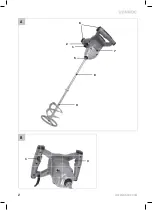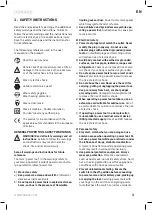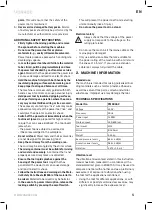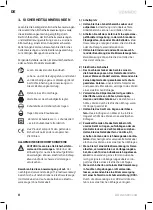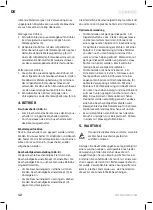
6
EN
WWW.VONROC.COM
• The times when the tool is switched off or when
it is running but not actually doing the job, may
significantly reduce the exposure level.
Protect yourself against the effects of vibration by
maintaining the tool and its accessories, keeping
your hands warm, and organizing your work patterns.
DESCRIPTION
The numbers in the text refer to the diagrams on
page 2.
1. On/off switch
2. Lock-on button
3. Speed adjustment wheel
5. Tool holder
6. Handle
7. Ventilation apertures
8. Whisk shaft
9. Whisk paddle
3. ASSEMBLY
Assembling the two-part whisk (Fig. A)
1. Screw the Whisk shaft (8) onto the Whisk pad-
dle (9)
2. Tighten both parts securely
Replacing the whisk (Fig. A)
Before assembly, always switch off the
machine and remove the mains plug from
the mains.
Use only whisks conform the specified diameter.
Always use a whisk that is suitable for the material
to be mixed/stirred. Using an unsuitable mixer bar
can unnecessarily overload both the machine and
yourself.
Mounting the whisk
1. Screw the assembled whisk into the tool holder
(5) in clockwise direction as far as possible.
2. Tighten the whisk into the tool holder using
the supplied spanners. To do so, hold the tool
holder (5) using one of the supplied spanners,
and use the second spanner to tighten the
assembled whisk.
Removing the whisk
1. Loosen the assembled whisk using the supplied
spanners. To do so, hold the tool holder (5)
using one of the supplied spanners, and use the
second spanner to loosen the assembled whisk.
2. Unscrew the whisk from the tool holder (5) in
anti-clockwise direction.
4. OPERATION
Switching on and off (Fig. A)
• To switch on the tool, press and hold the on/off
switch (1).
• If you release the on/off switch, the tool will be
switched off.
You can lock the on/off switch by pressing the
on/off switch (1) and then button (3). The switch
lock can be released by briefly pressing the on/off
switch.
Speed adjustment (Fig. B)
The required speed can be adjusted by using the
Speed adjustment wheel (3). Also during operation
the rotational speed can be adjusted.
• To increase the speed, turn the Speed adjustment
knob (3) clockwise.
• To decrease the speed, turn the Speed adjustment
knob (3) anti-clockwise.
The required speeds depends on the material
and can be determined by practical testing.
Optimum use
• For materials with low viscosity, e.g. emulsion
paint, varnishes, adhesive, grouting compound
and cement slurry, a stirrer whisk with a so-cal-
led left-hand spiral is recommended for opti-
mum use. With a left-hand spiral, the material is
moved from the top downwards and the stirrer
whisk is pushed upwards. Materials with low
viscosity are mixed in a way which minimises
splattering, so a low speed is recommended.
• For materials with high viscosity, e.g. plaster,
concrete, cement, screed, filler and epoxy resin,
a stirrer whisk with a so-called right-hand spiral
is recommended for optimum use. With a right-
hand spiral, the material is moved from the
bottom upwards and the stirrer whisk is pulled
downwards (working its way into the mixture).
Materials with high viscosity are mixed thoroug-
hly, so a high speed is recommended.
• For optimum results, move the power tool in an
up and down motion while mixing.


